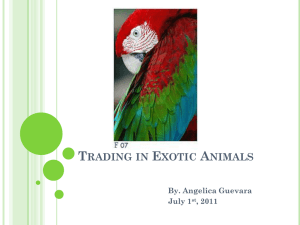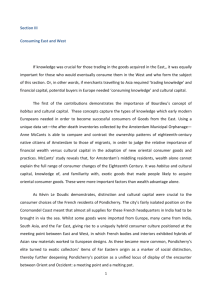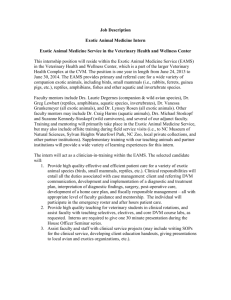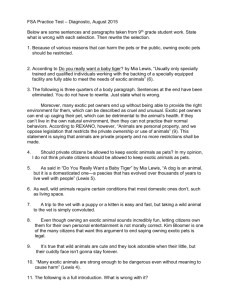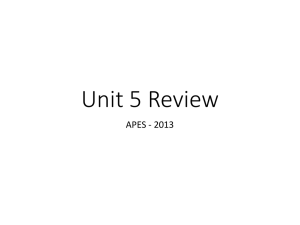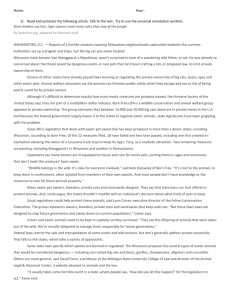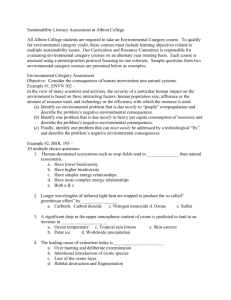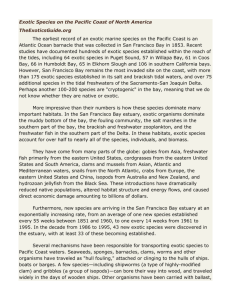Lesson Plan - KBS GK12 Project
advertisement
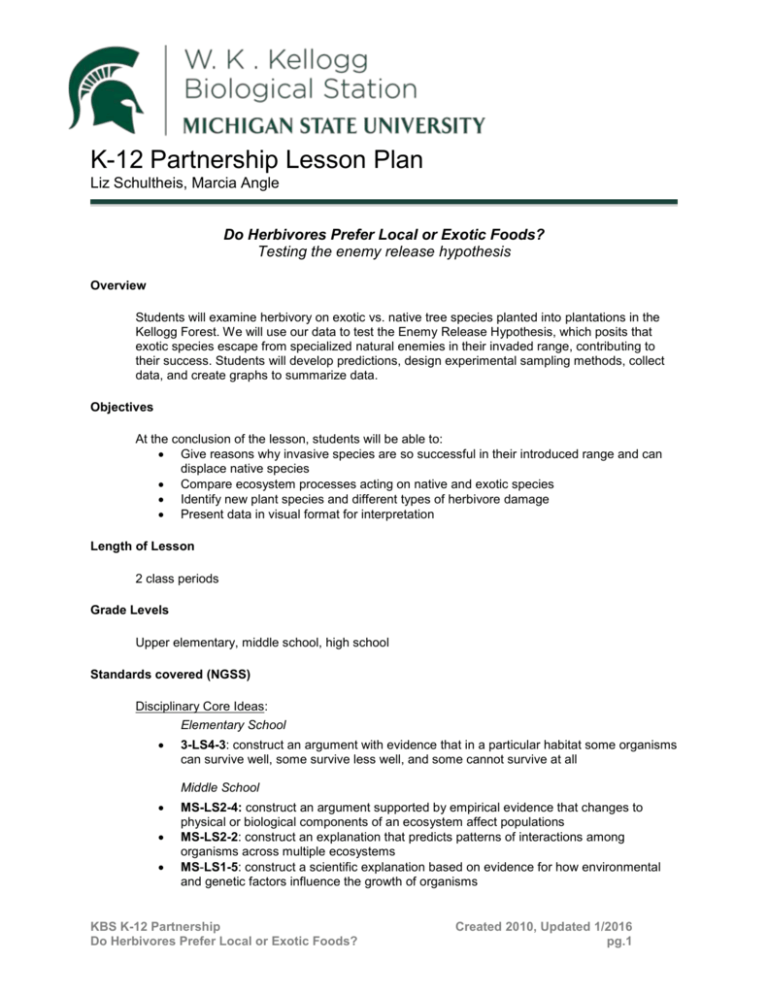
K-12 Partnership Lesson Plan Liz Schultheis, Marcia Angle Do Herbivores Prefer Local or Exotic Foods? Testing the enemy release hypothesis Overview Students will examine herbivory on exotic vs. native tree species planted into plantations in the Kellogg Forest. We will use our data to test the Enemy Release Hypothesis, which posits that exotic species escape from specialized natural enemies in their invaded range, contributing to their success. Students will develop predictions, design experimental sampling methods, collect data, and create graphs to summarize data. Objectives At the conclusion of the lesson, students will be able to: Give reasons why invasive species are so successful in their introduced range and can displace native species Compare ecosystem processes acting on native and exotic species Identify new plant species and different types of herbivore damage Present data in visual format for interpretation Length of Lesson 2 class periods Grade Levels Upper elementary, middle school, high school Standards covered (NGSS) Disciplinary Core Ideas: Elementary School 3-LS4-3: construct an argument with evidence that in a particular habitat some organisms can survive well, some survive less well, and some cannot survive at all Middle School MS-LS2-4: construct an argument supported by empirical evidence that changes to physical or biological components of an ecosystem affect populations MS-LS2-2: construct an explanation that predicts patterns of interactions among organisms across multiple ecosystems MS-LS1-5: construct a scientific explanation based on evidence for how environmental and genetic factors influence the growth of organisms KBS K-12 Partnership Do Herbivores Prefer Local or Exotic Foods? Created 2010, Updated 1/2016 pg.1 High School HS-LS2-6: evaluate the claims, evidence, and reasoning that the complex interactions in ecosystems maintain relatively consistent numbers and types of organisms in stable conditions, but changing conditions may result in a new ecosystem Cross Cutting Concepts: Patterns Stability and change of systems Science and Engineering Practices Planning and carrying out investigations Analyzing and interpreting data Using mathematical and computational thinking Engaging in argument from evidence Previous Michigan Standards Met: S.IP.E.1: inquiry involves generating questions, conducting investigations, and developing solutions to problems through reasoning and observation S.IA.E.1: inquiry includes an analysis and presentation of findings that lead to future questions, research, and investigations B3.4x: changes in ecosystems. Human impact. Humans have tremendous impact on the environment. Sometimes beneficial and sometimes detrimental. B3.5C: predicting the consequences of an invading organism on the survival of other organisms B5.3d: explain how evolution through natural selection can result in changes in biodiversity Materials ● ● ● ● ● ● ● Ziploc bags (3 per group x 5 groups = 15) Clipboards (5) Calculators (5) Measuring tape (5) Pens and sharpies Handouts (found on “Do Herbivores Prefer Local or Exotic Foods” lesson page on the KBS GK-12 website) Data sheets (online) Background Classes of species: Invasive species – Species that have been introduced to an environment where they are not native, and that subsequently become a nuisance through rapid spread and increase in numbers, often to the detriment of native species and ecosystem processes. Exotic species – Species that have been moved to an area outside their natural range, usually by human transport. Native species – Species that occur naturally in an area Herbivory – the consumption of plants. Enemy release – release from natural enemies when an exotic or invasive species is introduced to a new range. Biocontrol - Control of invasive species by the introduction of natural predators, parasites, or pathogens from their native range. Where they invade, invasive species cause damage to ecosystems – lowering biodiversity by displacing native species and changing ecosystem processes, such as nutrient cycling and hydrology. For this reason, it is of great interest to scientists and land managers to discover the KBS K-12 Partnership Do Herbivores Prefer Local or Exotic Foods? Created 2010, Updated 1/2016 pg.2 mechanisms behind the success of invasive species. One of the predominant hypotheses explaining the success of invasive species is the Enemy Release Hypothesis. This hypothesis posits that when exotic plants invade new regions, they escape their natural enemies. As a result, herbivores and pathogens that may limit population growth rates (and distributions and abundances) in the native range are often absent in their new range. Accordingly, exotic plants enjoy increased success compared to native plant competitors, which are still battling all their enemies AND competing with the novel invaders. A recent experiment (Carpenter & Cappuccino, 2005 Ecology) illustrates this pattern. They found that exotic plants suffered significantly lower levels of herbivory damage when compared to native plants, and that the most invasive species experienced the greatest “release” of all (see Figure). The plantations in the Kellogg Forest provide excellent venues to test the Enemy Release Hypothesis. In these plantations, foresters have planted a wide variety of tree species into common habitats. Many of these species are native to Michigan, but many others are exotic. We will use the oak plantation and record herbivore damage and diversity on native versus exotic species. The oak plantation contains 3 oak species—two native (red oak and white oak) and one exotic (English oak). Activities of the session 1. Distribute handout to students (included). 2. Introduce students to why invasive species are of concern to scientistand land managers, discussing issues they cause for native species and ecosystems. 3. Define terms needed to understand the lesson (provided in background). 4. Ask students, in small groups, to brainstorm about characteristics of species that would make them better invaders, or aspects of ecosystems that would make them vulnerable to invasion. Discuss answers as a class. 5. Introduce the Enemy Release Hypothesis and why reduced herbivory in exotic ranges contributes to invasive plant success. 6. Explain an example of biocontrol and why this is relevant to enemy release. 7. Share plants that will be used in the study, and teach students how to distinguish them. 8. After observing leaves, have students choose three types of herbivore damage that they will measure out in the field (ex. galls, leaf miners, leaf removal). 9. Label bags. Distribute data collection sheets (included). 10. Take students out into the field. Introduce students to proper sampling methods, such as randomly selecting plants to sample, and consistency between groups’ sampling methods. 11. Break them into small groups and have each group collect 10 leaves from each species used in the study. Provide each group a Ziploc bag for leaves (one for each species used in the study). KBS K-12 Partnership Do Herbivores Prefer Local or Exotic Foods? Created 2010, Updated 1/2016 pg.3 12. Measure diameter at breast height (DBH) of each tree where leaves were collected. Observe tree height. 13. Bring students back to the classroom to identify herbivory on leaves. Have students estimate the amount of each kind of herbivore damage, and the diversity of herbivores attacking each leaf (how many different kinds of damage each leaf has). 14. Have everyone average their results and draw graph of the individual group results. 15. Submit group averages to teacher. 16. Discuss biodiversity and photosynthesis process tools. 17. Average the class results for each species, and present herbivory damage as a bar graph. On graph for each kind of damage. 18. Have students predict which species they think is the exotic, and which is native, based on the data collected. Why? 19. Share with students which species is exotic, and discuss as a class why your data may have supported or not supported predictions. 20. Have the students think as land managers. Based on the results from this study, would you recommend that people be allowed to plant the exotic oak species in their yards? What do you think would happen to the population of the exotic and native oaks over time? What would happen to the population of herbivores over time? Resources Literature on the Enemy Release Hypothesis Keane, R.M. & M.J. Crawley (2002) Exotic plant invasions and the enemy release hypothesis. Trends in Ecology & Evolution, 17(4) 164-169. Website to look up native and exotic plants in Michigan http://plants.usda.gov/ http://www.wildflower.org/plants/ Extensions and Modifications This project could be modified to include any plant species the teacher chose to use. Teachers can explore the habitats around their school and identify native and exotic species that occur together and might have comparable types of herbivore damage. The Bioenergy Plots established at each school for the GK-12 program could also be used for this project. We will be planting in native prairie species into the high diversity plots, but exotic and invasive species will invariably enter the plots from the seed bank and surrounding habitats. Teachers could select species found in these plots to use in the study. KBS K-12 Partnership Do Herbivores Prefer Local or Exotic Foods? Created 2010, Updated 1/2016 pg.4
